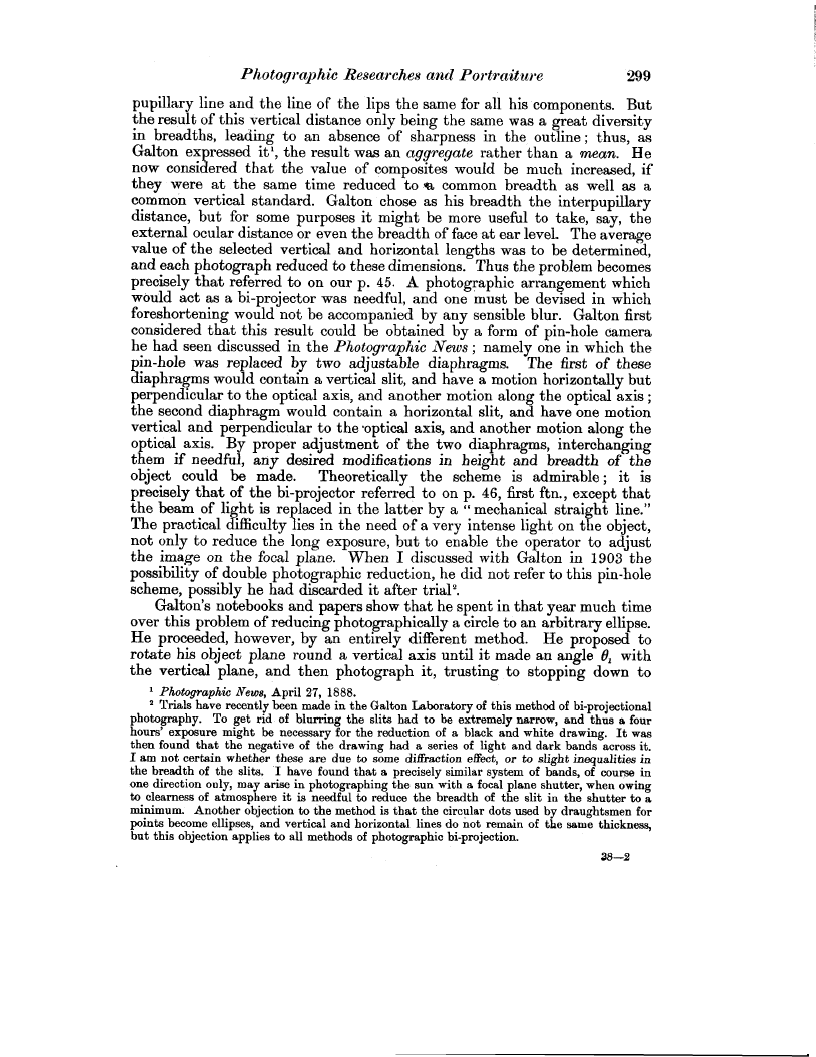Photographic Researches and Portraiture 299
pupillary line and the line of the lips the same for all his components. But the result of this vertical distance only being the same was a great diversity in breadths, leading to an absence of sharpness in the outline ; thus, as Galton expressed it', the result was an aggregate rather than a mean. He now considered that the value of composites would be much increased, if they were at the same time reduced to v, common breadth as well as a common vertical standard. Galton chose as his breadth the interpupillary distance, but for some purposes it might be more useful to take, say, the external ocular distance or even the breadth of face at ear level. The average value of the selected vertical and horizontal lengths was to be determined, and each photograph reduced to these dimensions. Thus the problem becomes precisely that referred to on our p. 45. A photographic arrangement which would act as a bi-projector was needful, and one must be devised in which foreshortening would not be accompanied by any sensible blur. Galton first considered that this result could be obtained by a form of pin-hole camera he had seen discussed in the Photographic News; namely one in which the pin-hole was replaced by two adjustable diaphragms. The first of these diaphragms would contain a vertical slit, and have a motion horizontally but perpendicular to the optical axis, and another motion along the optical axis ; the second diaphragm would contain a horizontal slit, and have one motion vertical and perpendicular to the -optical axis, and another motion along the optical axis. By proper adjustment of the two diaphragms, interchanging them if needful, any desired modifications in height and breadth of the object could be made. Theoretically the scheme is admirable ; it is precisely that of the bi-projector referred to on p. 46, first ftn., except that the beam of light is replaced in the latter by a " mechanical straight line." The practical difficulty lies in the need of a very intense light on the object, not only to reduce the long exposure, but to enable the operator to adjust the image on the focal plane. When I discussed with Galton in 1903 the possibility of double photographic reduction, he did not refer to this pin-hole scheme, possibly he had discarded it after trial'.
Galton's notebooks and papers show that he spent in that year much time over this problem of reducing photographically a circle to an arbitrary ellipse. He proceeded, however, by an entirely different method. He proposed to rotate his object plane round a vertical axis until it made an angle 01 with the vertical plane, and then photograph it, trusting to stopping down to
1 Photographic News, April 27, 1888.
2 Trials have recently been made in the Galton Laboratory of this method of bi-projectional photography. To get rid of blurring the slits had to be extremely narrow, and thus a four hours' exposure might be necessary for the reduction of a black and white drawing. It was then found that the negative of the drawing had a series of light and dark bands across it. I am not certain whether these are due to some diffraction effect, or to slight inequalities in the breadth of the slits. I have found that a precisely similar system of bands, of course in one direction only, may arise in photographing the sun with a focal plane shutter, when owing to clearness of atmosphere it is needful to reduce the breadth of the slit in the shutter to a minimum. Another objection to the method is that the circular dots used by draughtsmen for points become ellipses, and vertical and horizontal lines do not remain of the same thickness, but this objection applies to all methods of photographic bi-projection.
38-2

